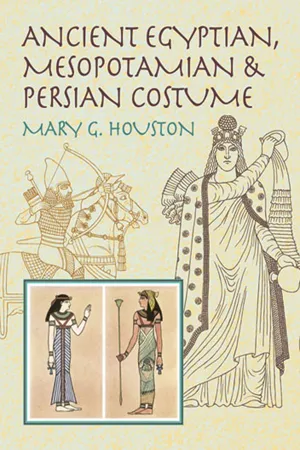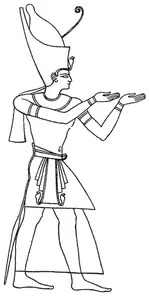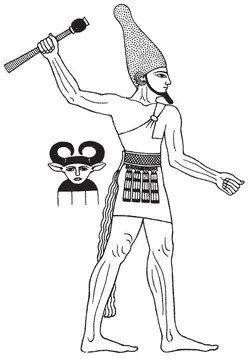
This is a test
- 208 pages
- English
- ePUB (mobile friendly)
- Available on iOS & Android
eBook - ePub
Ancient Egyptian, Mesopotamian & Persian Costume
Book details
Book preview
Table of contents
Citations
About This Book
Clothing was hardly a practical necessity in North Africa and what is today the Middle East. Often a luxury item in these warm, humid climates, it became more essential as people's lives improved socially and economically. But even then, the drapery was light and tended to accent the body's shape rather than conceal it. The first part of this profusely illustrated and scrupulously researched text examines the evolution in apparel worn by Egyptian royalty, priests, musicians, manual workers, the military, and foreigners (as depicted by Egyptian artists). Two additional sections consider clothing worn in ancient Mesopotamia and Persia, focusing largely on Sumerian, Babylonian, and Assyrian styles. Over 250 illustrations, drawn in the artistic style of the period, are accompanied by flat patterns showing the cut of the garment, thus enabling today's costumers to accurately reconstruct this apparel. A comprehensive archive that will not only be of immense value to fashion historians and students of costume design, this volume will also fascinate anyone interested in the development of artistic representation.
Frequently asked questions
At the moment all of our mobile-responsive ePub books are available to download via the app. Most of our PDFs are also available to download and we're working on making the final remaining ones downloadable now. Learn more here.
Both plans give you full access to the library and all of Perlego’s features. The only differences are the price and subscription period: With the annual plan you’ll save around 30% compared to 12 months on the monthly plan.
We are an online textbook subscription service, where you can get access to an entire online library for less than the price of a single book per month. With over 1 million books across 1000+ topics, we’ve got you covered! Learn more here.
Look out for the read-aloud symbol on your next book to see if you can listen to it. The read-aloud tool reads text aloud for you, highlighting the text as it is being read. You can pause it, speed it up and slow it down. Learn more here.
Yes, you can access Ancient Egyptian, Mesopotamian & Persian Costume by Mary G. Houston in PDF and/or ePUB format, as well as other popular books in Design & Fashion Design. We have over one million books available in our catalogue for you to explore.
Information
Topic
DesignSubtopic
Fashion Design
SECTION I
ANCIENT EGYPTIAN COSTUME
INTRODUCTION
IN this section Ancient Egyptian costume is described, together with some examples of the dress of those foreign nations whose figures are so frequently depicted in Egyptian sculptured and painted wall-decorations. A special chapter is devoted to Hittite costume.
When studying the costume of any country or period we find, in the case of Ancient Egypt alone, that we are confronted with an extraordinary conservatism or persistence of style, not only through centuries but even through milleniums.
This statement, however, must be qualified, for it is a fact that in the latest stages of Ancient Egyptian civilization as, for example, that of the long line of monarchs who reigned after the Alexandrian conquest, these Ptolemaic Pharaohs of the sculptures and paintings did not, in fact, wear the garments in which they were depicted by the Egyptian artists of the period, but rather were habited in the Greek dress of their conquering ancestors.
In addition, we have the archaistic revival of the 26th (Saite) Dynasty, 661-525 B.C., where a renaissance of the art of the Old Kingdom became the vogue, so that, in the tomb of a Saite noble of this period, at Thebes, the whole of the costumes are copied, in facsimile, from tomb pictures of the 6th Dynasty, and it is difficult for anyone not an expert to decide to which date the Saite costume really belongs. Yet in life this nobleman was certainly clad in the more elaborate dress of his own time.
The archaistic modes as represented in the tombs during this late period have been compared by Egyptologists to the seventeenth- and eighteenth-century fashion in Europe, where kings and noblemen were represented as clad in the armour or in the toga of Ancient Rome, which they certainly never wore in actual life.
This is not to say that Egyptian costume shews no changes or developments throughout its incredibly long history of over 3,000 years. Those which do appear, however, are not of a striking magnitude save in one instance, namely, at the period of that great break in Egyptian history known as the domination of the Hyksos or Shepherd Kings, who invaded and conquered Egypt, bringing from their native Asia, among other things, a distinctly new element into the dress of the Egyptians.
We are well aware of these changes in costume when a great revival in native art took place after the Hyksos had been driven out and the Egyptian Pharaohs of the great 18th Dynasty ruled the land. Yet it may be said that these changes were in the nature of additions and developments based upon the old style of dress, which never completely disappeared.
To give a comprehensive list of the dates of each of the Egyptian kings from Menes of the 1st Dynasty to Cleopatra, who was the last monarch of the 33rd Dynasty, would be beyond the scope of this volume and, for those seeking it, the information is readily accessible in the works of numerous Egyptologists.
It will be helpful at the same time to give a few of the most outstanding dates in sequence. This sequence is generally agreed upon by most authorities, though by some it is placed at an earlier epoch in the world’s history than by others. It will be obvious that, for the sake of consistency, the dates here given must be chosen from the works of one of the two datings only.
The dynasties of the rulers of Egypt have been divided into those of:
“The Old Kingdom,” including 1st to 8th Dynasties, 3407 B.C.
“The Middle Kingdom,” including 9th to 17th Dynasties, 2111 B.C.—this Middle Kingdom covers the Hyksos period of the 15th to 17th Dynasties.
“ The New Kingdom or Empire,” including the 18th to 26th Dynasties, 1596 B.C.
The Persian Conquest, including 27th to 32nd Dynasties, 525 B.C.
The Greek Conquest coincides with the 33rd Dynasty, 332 B.C.–50 B.C.
The Roman Era which followed corresponded with the disappearance of Ancient Egyptian costume and ornament in its pure form.

Fig. 1.
CHAPTER I
COSTUMES OF THE OLD KINGDOM
THE very simple costumes of the Old Kingdom consisted of a kilt of varying lengths for men, and for women a tight-fitting tunic reaching from breast to ankles and kept in place by braces passing over each shoulder. Both sexes are occasionally seen wearing a cloak of thick material.
Among the most ancient representations of Egyptian costume which are known to us is that of the figure of the pre-dynastic King Narmer (3407 B.C.). In Fig. 1 he is seen wearing the tall white crown of Upper Egypt (the “ Het ”), also a plain corselet held in place by one brace, and a short plain kilt with a belt from which ornamental pendants hang down in front. Each pendant has at the top a representation of the goddess Hathor’s head, and this is shewn at the side of the figure to a larger scale. At the back of the belt is fastened the ceremonial animal’s tail which persists as a part of the kings of Egypt until the end of their history. On the chin of Narmer we see the ceremonial artificial beard of a king, which is fastened by straps to his crown. The figure of this king is taken from that very ancient fragment decorated with figures in relief and called “The Palette of Narmer,” a memorial tablet shewing the king in battle. The beards of gods, kings and noblemen were each different in shape, each symbolic of their wearers. This symbolism, so intricate in its character and so predominantly a feature of the dress of the Egyptian gods, is often transferred to the royal costumes ; hence we see a king in the dress of a god, and frequently both gods and goddesses are represented as wearing the crowns of Upper and Lower Egypt (see Plate I).
In the present volume the costumes are considered mainly as being examples of period and silhouette, and also from the constructive or technical viewpoint; but in the bibliography appended on pp. 188 there are given the names of books dcaling specially with Ancient Egyptian symbolism, and perhaps one of the most informative in connection with this aspect of costume is The Gods of the Egyptians, by Sir E. A. Wallis Budge (1904), which has numerous plates in colour of the gods in their symbolic costumes. In Manners and Customs of the Ancient Egyptians by Sir J. Gardner Wilkinson (ed. 1878) there is also special information on ...
Table of contents
- Title Page
- Copyright Page
- INTRODUCTION
- NOTE ON THE SECOND EDITION
- Table of Contents
- Table of Figures
- SECTION I - ANCIENT EGYPTIAN COSTUME
- SECTION II - ANCIENT MESOPOTAMIAN COSTUME
- SECTION III - ANCIENT PERSIAN COSTUME
- BIBLIOGRAPHY